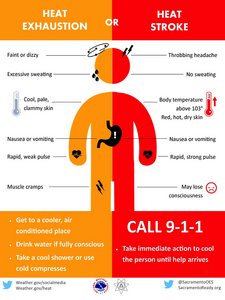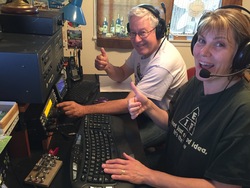 July 27, 2016 Editor: Paul Bourque, N1SFE | |||
IN THIS ISSUE
During this somewhat quiet contesting period, the RSGB IOTA (Islands on the Air) event is an opportunity to go into the field and work a number of stations. If you do go, make sure you are aware of the rules, including frequency restrictions, and that you post your planned operation on the IOTA Activation page so others will look for you. If you've not activated an island before, it might be best to pick one with scheduled ferry service, electricity, and other amenities. The North American QSO Party, CW, is on August 6th. With a maximum power level of 100 Watts, and 63 possible per-band multipliers, everyone can be on more equal footing. You can also join up with others to field a team of up to five stations. Etienne, K7ATN, submits: The 39th Annual August UHF Contest lives on with independent sponsorship from V/UHF clubs and individuals around the country. See http://www.augustuhf.org or http://uhfcontest.org For those interested in the bands 222MHz and up, for nearly four decades the August UHF Contest has defined what it takes to challenge "The Ultra Highs." When the ARRL VHF Contest Revitalization Committee cancelled the UHF Contest in March, several groups stepped in immediately to maintain the event for 2016. The contest rules are the same as 2015 with the addition of allowing Mobile entries as Rovers in a single grid square. Cabrillo or paper logs will be accepted and the Northern Lights Radio Society will continue to offer its "Rovermania" awards for Rovers operating in this contest on three bands. The contest sponsors are encouraging everyone to give these bands a try during the first weekend in August, with potential QSOs on 223.5-FM and 446.0-FM -- capabilities that you may already have in an HT or mobile rig. Weak-signal frequencies will likely be the busiest during the contest. Log entries of any size, on paper or electronically submitted, are encouraged. For some logging programs, use "ARRL UHF August" as the contest for correct rules and scoring. See the links above for rules, log submission information, and log forms. BUSTED QSOS QRU Complete information for all contests follows the Conversation section July 28 July 29 July 30 August 1 August 3 August 4 August 5 August 6
August 7 August 10 YOTA (Youth on the Air) 2016 just finished up in Austria. From the enthusiasm of the tweets of some of the attendees, it appears to have been a success. With workshops ranging from antenna building to contesting to WSPR, the gathering afforded 90 youth attendees the opportunity to learn among their peers. Two US amateurs, Sterling, N0SSC, and Sam, KC2LRC, attended, sponsored in part by the Northern California DX Foundation. Doug, KR2Q, the recently appointed CQWW Contest Director, has suspended the single position of Director, in lieu of a triumvirate of co-Directors, to include Scott, W4PA, and Bob, W5OV. Doug states that as all co-Directors are equal, and that the contest leadership will benefit from additional resources and resilience. Carnegie Mellon University recently obtained a grant from the National Science Foundation to develop automated means of creating accurate 3D models and collecting high-resolution images using UAVs, with the intent of eliminating the need for humans to climb on or rappel from bridges, towers, and other infrastructure. Imagine being able to have changes in radio tower condition called out for attention automatically. Two FlexRadio FLEX-6700 radios were launched into space for rendezvous with the International Space Station on July 18. They are going to be used as part of an experiment receiving AIS (Automatic Identification System) signals from orbit. Proper ergonomics can go a long way toward mitigating some of the ill effects of sitting in front of a radio during an entire contest weekend. If sitting isn't your thing, the Altwork Station may provide standing or reclining options. Car seats are also apparently getting smarter at detecting when drivers are too fatigued to continue. Perhaps we'll see desk chairs that can help determine when an operator change is due.
Summer is the time to work on antennas outside, but with 48 states currently experiencing very hot weather, are you prepared to tell the difference between heat exhaustion and heat stroke? One is treatable, one is life threatening. The National Weather Service has a tweet to help. Trap: A parallel tuned circuit used to electrically isolate one section of an antenna from another.
HamRadio360.com recently interviewed Wayne, K6KR, regarding the recently released Elecraft KX2, including some of the design decisions. There's even some poetry. Wayne's interview starts at about 32:50. Here's a YouTube video of totally remote multi-multi contesting at W4AAW. A number of remoting technologies are used or available at this station, with a discussion of the trade-offs. The North American QRP CW Club has posted a video about their organization, which is free to join. The club sponsors novelty challenges during the year, involving working stations, and then combining the letters of the worked calls to complete various phrases. (Paul, N8XMS) The results of the 2016 ARRL International DX Contest have been posted to the ARRL website. Notably, W3LPL wrested the top spot in multi-multi from the K3LR team after a 3-year reign, and K9YC achieved more than nine times the score of his closest competitor. The 2016 ARRL RTTY Roundup results were recently updated to reflect a minor change to a plaque category. Use a second VFO for more contacts. If you're not set up for SO2R (single operator, two radio) operation, or if you're assigned to a band in a multi-op, you can still use a second VFO (SO2V) to line up and work additional contacts or better yet, multipliers, between contacts made using the main VFO. Getting comfortable working the other VFO can also help if you do try SO2R in the future. Some logging programs will assist you in hunting multipliers on the second VFO by providing a bandmap with stations to click. Presentations from the 2016 Dayton Antenna Forum are now available on the K3LR website. Included are presentations on (intentionally) bent-element Yagi antennas, the future of the ARRL Antenna Book, low band antennas at W3LPL, and wideband techniques used in OWA antennas. IEEE Spectrum recently published what amounts to a history of RFI, but which also includes an overview of some new technologies and services such as 5G and Citizens Broadband Radio Service (CBRS). Panadapters are considered one of the new must haves when contesting nowadays, as they increase overall situational awareness. Mark, K6UFO, found a very simple way to add a panadapter to his Elecraft K3: "The Win4K3Suite software now supports the SDRPlay SDR receiver as a panadapter. I ordered an SDRPlay from Ham Radio Outlet. When received, I installed the drivers as described by "Start Here" at SDRPlay, then downloaded and installed Win4K3Suite with a 30-day free trial. I connected my K3 and made a few initial settings and the panadapter was working! I wanted to use my Writelog logging software to control the K3, so I used Win4K3's 'AUX/CAT' feature to provide a virtual serial port connection to Writelog while Win4K3 was physically connected to the K3. All of this is documented in the Win4K3 manual. I created a pair of virtual serial ports using Microham software, but Eltima or Com0com would have also worked. Now my K3 connects to Win4K3, and one of Win4K3's 'CAT/AUX ports' connects to my logging software. Both Win4K3 and Writelog can control the radio, and I have a panadapter! I purchased Win4K3 for $50, to bring my total panadapter cost to $200. Other SDR software can be used with the SDRPlay, but Win4K3 is already setup for a K3 and the SDRPlay as a panadapter, so it was very straightforward." Doldrums? Typical this time of year is to hear about how to beat the summer doldrums, what to read at the beach, and how its difficult to get anything done because people are out of town. This is a time of opportunity. First, there's still the glow of the well-contested IARU from the July 9 weekend. It's a good time to get the station ready for the upcoming contest season at a more leisurely pace, planning instead of reacting. Don't discount the upcoming non-US-centric contests -- the announcements of operations planned for the WAE DX coming up on August 15 in The Daily DX indicate that there will be plenty of activity. I'm personally using the next few weeks to get some auto-switching stub filters working for a multi-op station, re-packaging my CW keyer, working on a remote station, getting my home station in better order, visiting New England and W1AW, finishing a 50 MHz amplifier project, setting up for WSJT, and planning the weekend calendar for the fall. Doldrums? I'll be lucky to finish it all! That's all for this time. Remember to send contesting related stories, flea market pictures, book reviews, tips, techniques, press releases, errata, schematics, club information, pictures, stories, blog links, predictions, and field day recipes to contest-update@arrl.org 73, Brian N9ADG 28 Jul - 10 Aug 2016 An expanded, downloadable version of QST's Contest Corral is available as a PDF. Check the sponsor's website for information on operating time restrictions and other instructions. HF CONTESTS CWops Mini-CWT Test, Jul 27, 1300z to Jul 27, 1400z, Jul 27, 1900z to Jul 27, 2000z, Jul 28, 0300z to Jul 28, 0400z; CW; Bands: 160, 80, 40, 20, 15, 10m; Member: Name + Member No., non-Member: Name + (state/province/country); Logs due: July 30. VHF+ CONTESTS WAB 144 MHz Low Power Phone, Aug 6, 1400z to Aug 6, 1800z; Phone; Bands: 2m Only; British Isles: RS + serial no. + WAB square, Other: RS + serial no. + country; Logs due: August 27. August UHF Contest, Aug 6, 1800z to Aug 7, 1800z; All; Bands: 222 MHz and up; 4-character grid square; Logs due: September 6. July 28, 2016 July 29, 2016 July 30, 2016 July 31, 2016
August 1, 2016 August 8, 2016 August 9, 2016 ARRL Information Click here to advertise in this newsletter, space subject to availability. Your One-Stop Resource for Amateur Radio News and Information ARRL membership includes QST, Amateur Radio's most popular and informative journal, delivered to your mailbox each month. Subscribe to NCJ - the National Contest Journal. Published bimonthly, features articles by top contesters, letters, hints, statistics, scores, NA Sprint and QSO Parties. Subscribe to QEX - A Forum for Communications Experimenters. Published bimonthly, features technical articles, construction projects, columns and other items of interest to radio amateurs and communications professionals. Free of charge to ARRL members: Subscribe to The ARRL Letter (weekly digest of news and information), the ARES E-Letter (monthly public service and emergency communications news), Division and Section news -- and much more! ARRL offers a wide array of products to enhance your enjoyment of Amateur Radio. Visit the site often for new publications, specials and sales. Donate to the fund of your choice -- support programs not funded by member dues! Reprint permission can be obtained by sending email to permission@arrl.org with a description of the material and the reprint publication. ACKNOWLEDGMENTS ARRL Contest Update wishes to acknowledge information from WA7BNM's Contest Calendar and SM3CER's Contest Calendar. | |||








